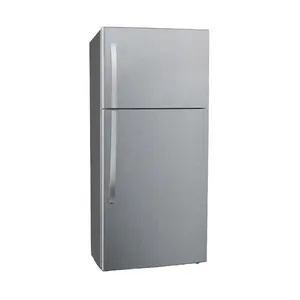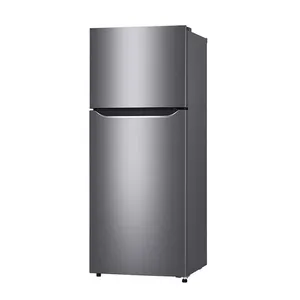(424734 products available)
















































































































































































































A refrigerator is a cooling machine that maintains low temperatures to keep food and beverages safe for longer. Refrigerators exist in several varieties; each kind differs in design and purpose. Thorough knowledge of these distinctions aids businesses in making educated decisions that will encourage growth at their organization.
Refrigerators work on sophisticated cooling systems. The cooling system is based on the principles of refrigeration physics. It removes heat from the inside and releases it outside, keeping the interior at a constant, low temperature. A thermostat controls the temperature to suit the storage needs. Some models have a system that cools the air evenly and prevents condensation.
Fridges have energy efficiency measures to reduce consumption while maintaining good performance. Energy efficiency consumes less power, reducing electricity bills and conserving natural resources. The global standard for rating a fridge's energy efficiency uses energy star certifications and makes energy consumption comparisons.
Storage space is a crucial feature of a refrigerator. Fridges come in various sizes, from tiny under-counter refrigerators to expansive walk-in chillers. They offer a range of capacities to suit different needs. Refrigerators have shelves, drawers, and door bins that are adjustable to help organize food and drinks properly.
Regular cleaning and maintenance are critical to a refrigerator's efficient running and lifespan. Maintaining appliances is simple. Basic maintenance operations, such as regularly cleaning the coils and checking seals for fridges that defrost naturally, can significantly impact their energy efficiency and performance.
Modern refrigerators operate quietly. They use compressors and fans designed to minimize operational noise. Manufacturers frequently report the noise level in decibels (dB) of a refrigerator. This allows buyers to choose models suited to their preferences and environment. For example, fridges placed in living areas or bedrooms need to minimize noise.
The global demand for refrigerators is expanding into new markets and usage scenarios. Modern manufacturers are now expanding product lines to cover various usage scenarios. They include the following;
Urban living spaces:
In any busy city, the average person spends about 8-10 hours in a small kitchen. Given the limited space, small refrigerators are ideal. They help keep food fresh without taking up too much space. A compact fridge is commonly found under the kitchen sink or in pantry cupboards.
Residential Homes:
Refrigerators are essential in any modern household. They come in numerous sizes and designs to meet the needs of each family. Homeowners usually choose fridges with separate temperature controls, built-in ice makers, and water dispensers.
Refrigerators, when equipped with freezers, ensure families have food stockpiled for future use. They won't have to worry about taking out ice trays or running out of frozen peas.
Gourmet kitchens:
Professional chefs need restaurant-grade refrigerators to prepare food on a large scale. Commercial fridges cool food quickly to prevent spoiling. Several types of refrigerators, such as roll-in fridges, blast chillers, and open display cases, are used in restaurants.
Retail businesses:
Convenient store refrigerators help retail business owners showcase products to customers. Merchandiser refrigerators with multiple glass doors are popular in retail stores. Ice cream shops use chest freezers to keep treats at low temperatures. Merchandiser refrigerators with multiple glass doors are also popular in retail stores.
Industrial Applications:
Industries that need low temperatures, such as hospitals and pharmaceutical companies, use laboratory freezers. These ultra-low temperature freezers keep specimens at less than -86C. Blast chillers are found in grocery stores and food processing facilities, where large quantities of food are chilled quickly.
Recreational and mobile applications:
A caravan fridge is useful during camping adventures. Iceboxes can keep drinks chilled for several hours. Marine fridges for elite boaters ensure food on sailboats and yachts stays fresh.
Refrigerator size:
Measure the kitchen space and find out the fridge's current capacity to determine the right-size refrigerator. The recent capacity is usually marked in cubic feet. A standard size fridge for a family of four ranges from 18 to 30 cubic feet. Those below 18 cubic feet are ideal for small kitchens or households. Side by side fridges need more space to open the doors fully compared to French or top freezer models. Besides the kitchen, unobstructed areas around the fridge should be measured too - at least an inch on the sides and top and four inches on the back are good clearances.
Q1: What does ft mean in a refrigerator?
A1: The abbreviation "ft" refers to "floor space," which indicates how much space a refrigerator will occupy in a kitchen. It can also refer to the measurement of the total refrigerator and freezer capacity in cubic feet.
Q2: How do I choose a refrigerator?
A2: Choosing a refrigerator depends on various factors, such as size, style, budget, energy efficiency, features, and preferences. The first step is to measure the available kitchen space and determine the required refrigerator capacity. Next, evaluate different refrigerator styles, including top freezer, bottom freezer, side-by-side, and French door, to find the best one that meets requirements.
Q3: What is the refrigerator definition?
A3: A refrigerator, also called a fridge, is a heat pump that removes heat from a low-temperature reservoir and transfers it to a high-temperature one. Refrigerators are widely used to cool and freeze food and beverages.